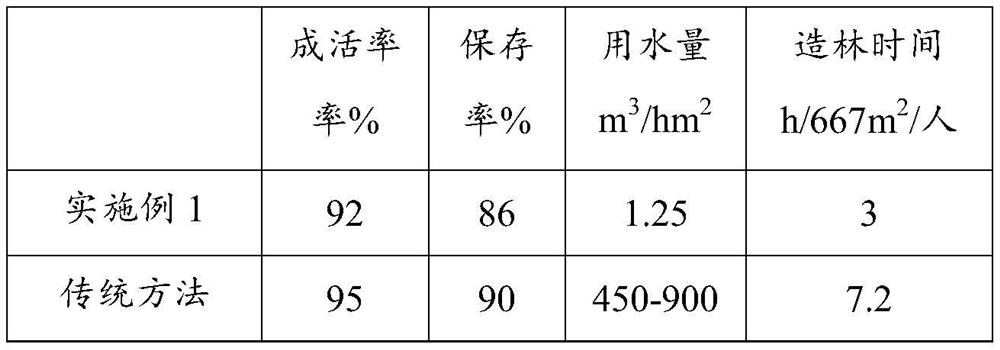Water-saving irrigation afforestation method and application thereof
A technology for tree species and seed strips, applied to water-saving irrigation and afforestation methods and application fields thereof, can solve the problems of lack of universality of water-saving irrigation agronomic technology, long construction time and high cost of large-scale water-saving irrigation projects
- Summary
- Abstract
- Description
- Claims
- Application Information
AI Technical Summary
Problems solved by technology
Method used
Image
Examples
Embodiment 1
[0066] A kind of water-saving irrigation tamarisk afforestation method, comprises steps as follows:
[0067] 1. Selection of tree species: Chinese Tamarix
[0068] 2. Selection of afforestation sites: The salinity of the soil generally requires 0.5-0.9% chloride saline soil, and the soil pH value is 8.0-8.4. The soil texture of the plantation land is sandy soil.
[0069] 3. Afforestation time: before germination in spring.
[0070] 4. Preparation of cuttings: Select the seedlings that are 1 to 2 years old, have a base diameter greater than 0.8cm, a small head diameter greater than 0.5cm, and are free from diseases and insect pests. It is cut into 18-20cm cuttings, graded according to diameter, counted and bundled.
[0071] 5 Cuttings soaking: Soak the cut cuttings in clean water for 1 day, change the water every 12 hours, and cut the cuttings in time after the water comes out.
[0072] 6. Key points of afforestation technology: the method of using agricultural high-pressur...
Embodiment 2
[0093] The difference with embodiment 1 is:
[0094] Soaking cuttings: Soak the cut cuttings in clear water for 3 days, change the water once every 12 hours, cuttages in time after the water comes out, and the rest of the conditions are the same as in Example 1.
[0095] The long soaking time will allow the cuttings to absorb water more fully, which helps to improve the survival rate. The survival rate of the shelterbelt planted in this embodiment is 93%, and the preservation rate is 84%.
Embodiment 3
[0097] The difference from Example 1 is that the spacing between plants and rows is 1m×3m, and the rest of the conditions are the same as in Example 1.
[0098] The wide spacing between plants and rows helps to optimize the distribution of nutrients and water in the sandy soil, and avoid vicious competition. The survival rate of the shelterbelts planted in this embodiment is 93%, and the preservation rate is 86%.
PUM
| Property | Measurement | Unit |
|---|---|---|
| Diameter | aaaaa | aaaaa |
Abstract
Description
Claims
Application Information
 Login to View More
Login to View More - R&D
- Intellectual Property
- Life Sciences
- Materials
- Tech Scout
- Unparalleled Data Quality
- Higher Quality Content
- 60% Fewer Hallucinations
Browse by: Latest US Patents, China's latest patents, Technical Efficacy Thesaurus, Application Domain, Technology Topic, Popular Technical Reports.
© 2025 PatSnap. All rights reserved.Legal|Privacy policy|Modern Slavery Act Transparency Statement|Sitemap|About US| Contact US: help@patsnap.com


